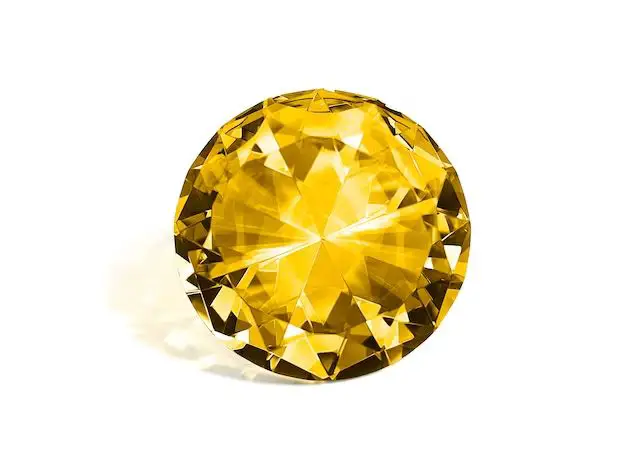There are a few different gemstones that exhibit a bright yellow color. Some of the most popular yellow gemstones include citrine, yellow sapphire, golden topaz, and yellow beryl. Each of these stones has its own unique properties and characteristics.
Citrine
Citrine is by far the most common yellow gemstone. It ranges in color from pale yellow to a deep orange-yellow and occurs in both transparent and opaque varieties. Citrine is a member of the quartz family and owes its yellow color to iron impurities within the crystal structure. Most citrine on the market today comes from Brazil, but it is also mined in Spain, Russia, France, Madagascar, and the United States.
Citrine is affordably priced and very durable, making it a great option for jewelry. It looks beautiful in both vintage and modern designs. In ancient times, citrine was thought to have healing powers and was known as the “healing quartz.” People believed it could rid the body of toxins and treat a wide range of illnesses.
Yellow Sapphire
Yellow sapphire belongs to the corundum family along with blue sapphire and ruby. While blue is the most common sapphire color, they can occur in almost every hue. Fine yellow sapphires have a lively golden or butterscotch color. Lower quality stones can be brownish or appear dirty yellow.
The yellow color comes from trace amounts of iron within the mineral. Yellow sapphires are mined in Sri Lanka, Thailand, Australia, and East Africa. Some of the most coveted “golden sapphires” hail from Sri Lanka and command very high prices. Yellow sapphires are durable enough for any type of jewelry and make stunning engagement rings or fashion rings.
Golden Topaz
Golden topaz is the perfect gemstone for anyone who loves a rich, warm yellow hue. Topaz naturally occurs in a range of warm colors, from pale yellow to orange-yellow and reddish orange. The most prized topaz comes from Brazil and the Ural Mountains of Russia. Depending on the intensity of the color, golden topaz can sometimes be mistaken for citrine quartz or yellow sapphire.
Most topaz used in jewelry today is actually colorless material that has been irradiated and heated to produce a permanent rich yellow color. This treated topaz is relatively affordable. Natural golden topaz is much more rare and can cost over $500 per carat. Topaz is an exceptionally hard and durable gemstone, rating 8 on the Mohs scale, so it is suitable for all types of jewelry.
Yellow Beryl
Beryl is a mineral family that includes emerald and aquamarine. The pure yellow type of beryl is known as heliodor. It ranges in color from pale lemon yellow to a brilliant yellow or amber. Most heliodor comes from Brazil, Russia, and Africa. Large gem-quality crystals are very rare.
Heliodor is one of the more expensive yellow gemstones because of its scarcity. It is considered a collector’s stone. Because heliodor is not as hard as many other gems, it should be worn in protected settings to prevent scratches and chips. It has incredible fire and brilliance, making it popular for beads, pendants, and accent stones.
Other Yellow Gemstones
There are several additional yellow gemstones that are less common but worth mentioning. These include:
- Imperial topaz – The most valuable type of topaz, with a rich reddish orange hue.
- Yellow jade – Jadeite that occurs in lemon yellow, green yellow, and orange yellow shades.
- Yellow diamond – Natural fancy yellow diamonds with vivid color
- Yellow zircon – Zircon is an underrated gemstone that can occur in bright yellow.
- Yellow fire opal – Fire opal exhibits yellow flashes of color.
How Yellow Gemstones Are Evaluated
The value of a yellow gemstone depends on several factors:
- Color – Deep, vivid yellows are more desirable. Brownish or muddy tones are less valuable.
- Clarity – Transparent, clean stones are preferred. Inclusions and flaws will decrease value.
- Cut – Proper cutting enhances the color and sparkle. Poorly cut stones are less prized.
- Source – For sapphires and topaz, certain sources are more prestigious.
- Carat – Larger yellow gems are exponentially rarer and costlier.
Like other colored gemstones, the most important factors are color and clarity. Vivid color has a huge impact on value. A deep golden yellow sapphire or topaz will be much more expensive than a pale version. And an eye clean stone is always preferred.
How to Choose a Yellow Gemstone
When shopping for a yellow gem, consider the factors below:
- What shade of yellow do you prefer? Match the stone to your coloring and style.
- Do you want a natural or treated stone? Natural colors cost more.
- What is your budget? Rare yellow diamonds cost a fortune.
- Do you need exceptional durability? Topaz and sapphire are very hard.
- Will the stone be set in a ring? Softer gems require protective settings.
It’s also wise to buy only from reputable jewelers to ensure you are getting exactly what you pay for. Request a gemological lab report for any expensive yellow gemstone.
Comparison of Yellow Gemstone Properties
Here is a helpful comparison chart summarizing the properties of key yellow gemstones:
| Gemstone | Hardness | Clarity Enhancement | Heat Treatment | Durability |
|---|---|---|---|---|
| Citrine | 7 | Rare | Common | Excellent |
| Yellow Sapphire | 9 | Rare | Uncommon | Excellent |
| Golden Topaz | 8 | Rare | Common | Excellent |
| Yellow Beryl | 7.5-8 | Uncommon | Uncommon | Good |
Conclusion
In summary, the most popular yellow gemstones are citrine, yellow sapphire, golden topaz, and yellow beryl. Citrine is the most common and affordable option. Yellow sapphire and imperial topaz are rare and precious. Beryl and other delicate stones require protective settings. Vivid color, transparency, and fine cutting result in the most desirable yellow gems.


